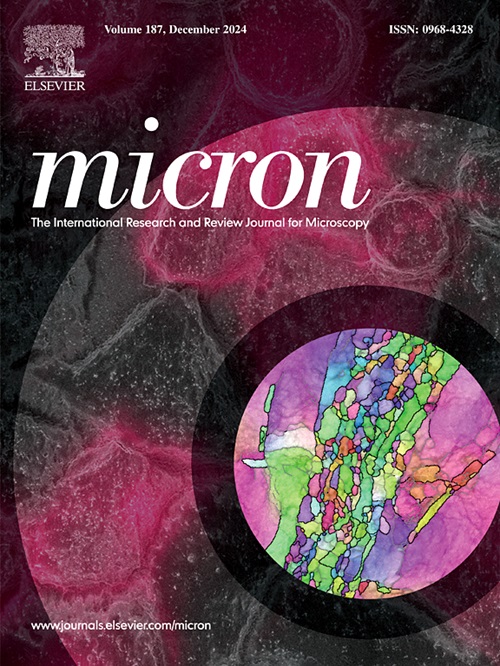Comparative electron diffraction analysis of strain relaxation in AlxGa1-xN materials in the microelectronics industry: 4D-STEM approach vs. TEM-based N-PED solution
IF 2.2
3区 工程技术
Q1 MICROSCOPY
引用次数: 0
Abstract
Owing to its high spatial resolution and its high sensitivity to chemical element detection, transmission electron microscopy (TEM) technique enables to address high-level materials characterization of advanced technologies in the microelectronics field. TEM instruments fitted with various techniques are well-suited for assessing the local structural and chemical order of specific details. Among these techniques, 4D-STEM is suitable to estimate the strain distribution of a large field of view. This study tends to discuss the viability of using two existing commercial solutions with a low-convergence angle 4D-STEM technique and TEM-based Nanobeam Precession Electron Diffraction (N-PED) methods for strain analysis in an industrial context. In such a framework, strain measurements intend to point out the extent of defects and thus reveal a trend of the stress field, rather than to precisely estimate the absolute values of the deformations. Strain distribution maps have been obtained for AlGaN/GaN HEMT devices using two transmission electron diffraction analysis methods. The performances of 4D-STEM and Nanobeam Precession Electron Diffraction (N-PED) solution for strain mapping have been compared for both a relatively thin (≈ 55 nm) and a thick (≈ 150 nm) TEM cross section specimen. The strain maps obtained with both methods have shown comparable results for a thin sample, with the ability to characterize the deformation induced by a 1 nm-thick layer of AlN spacer grown between the AlGaN barrier and GaN channel forming the 2DEG of the HEMT device. The results presented here also illustrate the limitation of both commercial solutions in the case of a thick sample.
微电子工业中AlxGa1-xN材料应变弛豫的比较电子衍射分析:4D-STEM方法与基于tem的N-PED解决方案。
由于其高空间分辨率和对化学元素检测的高灵敏度,透射电子显微镜(TEM)技术能够解决微电子领域高级材料表征的先进技术。采用各种技术的透射电镜仪器非常适合评估特定细节的局部结构和化学顺序。在这些技术中,4D-STEM适用于估计大视场的应变分布。本研究旨在讨论在工业环境中使用两种现有商业解决方案的可行性,即低会聚角4D-STEM技术和基于tem的纳米束进动电子衍射(N-PED)方法进行应变分析。在这种框架下,应变测量旨在指出缺陷的程度,从而揭示应力场的趋势,而不是精确地估计变形的绝对值。利用两种透射电子衍射分析方法获得了AlGaN/GaN HEMT器件的应变分布图。在相对较薄(≈55 nm)和较厚(≈150 nm)的TEM截面样品上,比较了4D-STEM和纳米束进动电子衍射(N-PED)溶液的应变映射性能。两种方法获得的应变图显示了薄样品的相似结果,能够表征在形成HEMT器件2DEG的AlGaN阻挡层和GaN通道之间生长的1 nm厚的AlN间隔层所引起的变形。这里给出的结果也说明了两种商业解决方案在厚样本情况下的局限性。
本文章由计算机程序翻译,如有差异,请以英文原文为准。
求助全文
约1分钟内获得全文
求助全文
来源期刊

Micron
工程技术-显微镜技术
CiteScore
4.30
自引率
4.20%
发文量
100
审稿时长
31 days
期刊介绍:
Micron is an interdisciplinary forum for all work that involves new applications of microscopy or where advanced microscopy plays a central role. The journal will publish on the design, methods, application, practice or theory of microscopy and microanalysis, including reports on optical, electron-beam, X-ray microtomography, and scanning-probe systems. It also aims at the regular publication of review papers, short communications, as well as thematic issues on contemporary developments in microscopy and microanalysis. The journal embraces original research in which microscopy has contributed significantly to knowledge in biology, life science, nanoscience and nanotechnology, materials science and engineering.
 求助内容:
求助内容: 应助结果提醒方式:
应助结果提醒方式:


